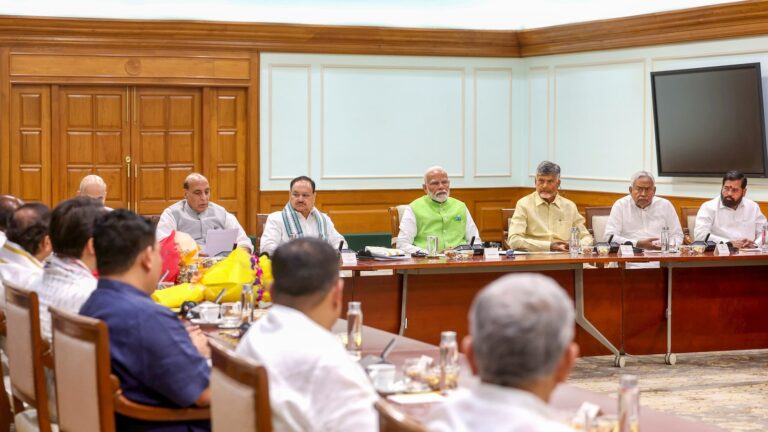The 2024 election outcome will be very different to what the exit polls predicted. Indeed, the National Democratic Alliance (NDA) still has a majority in the Indian lower house. What are the big stories from this election? Here are five charts that summarise them.
BJP is down compared to 2019, while NDA alliance is up
This is the biggest factor influencing the fate of the new NDA government. While the BJP has lost 63 seats from 303 in 2019, the other NDA allies have increased their seats from 49 in 2019 to 53 in 2024 (this includes the seats won by the Sikkim Krantikari Morcha in Sikkim, where the BJP also contested but lost). This means that the balance of power in the government will be clearly in favour of the alliance rather than the centralised governments led by the BJP in 2014 and 2019. To be sure, the BJP will have 58 more seats than when it led the Atal Bihari Vajpayee government in 1999, but the NDA had almost the same number of seats at that time, 299.
The Indian National Congress regained momentum, but it was more against other parties than against the Bharatiya Janata Party.
The main reason for the BJP’s successive majorities in 2014 and 2019 is its overwhelming dominance in head-to-head contests with the BJP. In head-to-head contests where both parties came first or second, the Congress won 12.2% and 7.9% in 2014 and 2019, respectively. This figure rises to 28.8% in 2024. Admittedly, this is still lower than in the 1999, 2004 and 2009 elections. The Congress fared much better in constituencies where it did not face the BJP head-to-head. Its winning percentage in these constituencies was 32.7% in 2024, the second highest since 1999 after the 2009 election. Admittedly, in absolute terms, the Congress won more seats than any other party in head-to-head contests with the BJP.
A tale of two styles of Mandal politics
If the BJP had been able to replicate its 2019 record of 62 seats in Uttar Pradesh, it would have crossed the mid-point of 272 seats in the Indian Lok Sabha. However, it has not even emerged as the largest party in the state, trailing the Samajwadi Party (SP) by four seats. The BJP’s predicament against the SP is very different from its performance in Bihar, where both the BJP and the NDA were able to minimise losses. What explains the difference in the performance of the INDIA bloc in Uttar Pradesh and Bihar? According to an HT analysis of the caste breakdown of the INDIA coalitions in the two states, the SP-led coalition had a more representative caste composition in Bihar than the RJD-led one. This led to the SP achieving nearly 60% vote share in Uttar Pradesh, while the RJD got just 17.4% in Bihar. This holds lessons for the future of Mandal politics vis-à-vis the BJP. It needs to have a broader base than the 1990s-style Muslim-Yadav coalition.
The BJP reached its peak in West Bengal in 2019.
West Bengal is the third largest state in India and sends 42 MPs to the Lok Sabha. The BJP won 16 seats in the state in the 2019 Lok Sabha elections, up from just two in 2014. However, despite heavy promotion, it faced a decline in both vote share and seat share in the 2021 state assembly elections. The BJP’s seat share and vote share in the 2024 elections are almost the same as its 2021 performance. This indicates that the BJP could not find any additional leverage to convert its 2019 performance into a win in West Bengal.
The plan to thwart a grand alliance against the BJP in Maharashtra worked only to an extent.
As India’s second-largest state by number of members in the Lok Sabha, the BJP faced an existential threat in the state when the Shiv Sena broke away from the NDA and formed the government after the 2019 state elections. HT’s vote share analysis of the 2014 state elections shows that when all four major parties – the BJP, Indian National Congress, Shiv Sena and Indian Congress – contested separately in Maharashtra, the BJP would have lost in more than three-quarters of the state’s assembly constituencies. The BJP tried to counter this consolidation by orchestrating a split between the Shiv Sena and Indian Congress. The 2024 results show that it only worked to an extent. The NDA won 17 of the 48 PC seats in the state, down from 41 in 2019 but still better than it would have done if the Shiv Sena and NCP had united and fought alongside the Congress.
Get updated on India News, Election Results, Election Results 2024 Live, Today Weather, Latest News & Top Stories from India and Around the World.

